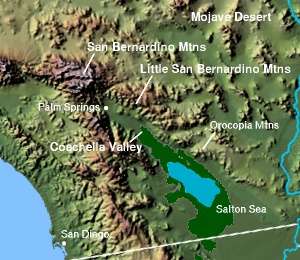Orocopia Mountains
The Orocopia Mountains are located in Riverside County in southern California, United States, east of the Coachella Valley, west of the Chuckwalla Mountains, and south of Interstate 10 in the Colorado Desert. The range lies in an east-west direction, and is approximately 18 miles long. The Orocopia Mountains are north of and overlooking the Salton Sea and south of Joshua Tree National Park, with the Chocolate Mountains to the southeast and the scenic Mecca Hills just northwest.
| Orocopia Mountains | |
|---|---|
Orocopia Mountains | |
| Highest point | |
| Elevation | 1,117 m (3,665 ft) |
| Geography | |
 location of Orocopia Mountains in California[1] | |
| Country | United States |
| State | California |
| District | Riverside County |
| Range coordinates | 33°34′00″N 115°46′33″W |
| Topo map | USGS Orocopia Canyon |
Orocopia Mountains Wilderness Area

The area is the Bureau of Land Management (BLM) designated and managed Orocopia Mountains Wilderness Area.[2] The Orocopia Mountains are in the Colorado Desert section of the Sonoran Desert, adjacent to the Lower Colorado River Valley region. Just to the north is the Mecca Hills Wilderness Area.
Flora and fauna
The Wilderness Area includes some remnant natural spring fed oasis with the only California native palm, Washingtonia filifera or the California Fan Palm.
History
The Bradshaw Trail passed through the mountains, the first recorded route to the Colorado River from Riverside, California.
Geology
The dramatic and variable terrain was shaped primarily by movements of the adjacent San Andreas Fault over millennia. Most notably, the Orocopia schist, a blueschist assemblage found in the range, matches the Pelona schist found over 250 km away in the San Gabriel Mountains along the San Andreas fault. Hill and Dibblee (1953) first noted this similarity (a piercing point), and used it to construct the first estimates of the offset on the fault.[3]
Astronaut training
The Orocopia Mountains offer considerable geologic variety and was one of the areas used for geologic field training by Caltech Professor of Geology, Leon T. Silver, for astronauts in preparation for the NASA Project Apollo Moon landing missions. This training included:[4]
- Apollo 13 Crew Training: September 1969: Astronauts Lovell, Haise and Swigert
- Apollo 14 crew did not train with Dr. Leon “Lee” Silver, they trained with Richard Henry Jahns, a Professor at Stanford at the time.
- Apollo 15 Crew Training: June 1970: Astronauts Scott, Irwin and Worden
- Apollo 16 Crew Training: April 1972: Astronauts Young, Mattingly and Duke
- Apollo 17 Crew Training: December 1972: Astronauts Cernan, Evans and Schmitt
See also
References
- "Orocopia Mountains". Geographic Names Information System. United States Geological Survey. Retrieved 2009-05-04.
- http://www.blm.gov/ca/pa/wilderness/wa/areas/orocopia_mountains.html Archived 2007-04-06 at the Wayback Machine. accessed 6/20/2010
- http://www.johnmartin.com/earthquakes/eqsafs/safs_371.htm
- "Geologic Field Training of NASA Astronauts Between January 1963 and November 1972" (PDF). Retrieved 2007-03-20.
- Allan, Stuart (2005). California Road and Recreation Atlas. Benchmark Maps. p. 112. ISBN 0-929591-80-1.
External links
- Orocopia Mountains Wilderness Area website
- Orocopia Mountains Wilderness photographs
- BLM Orocopia Mountains Wilderness Map
- CalTech: "Astronaut training in the Orocopias" article
- Mecca Hills Wilderness Area ( adjacent to north )
- U.S. Geological Survey Geographic Names Information System: Orocopia Canyon